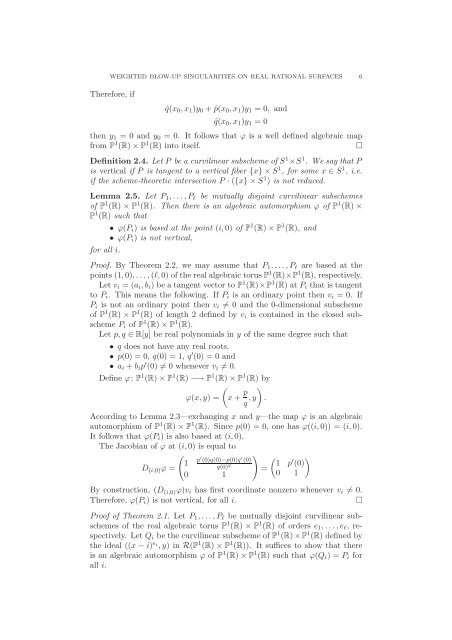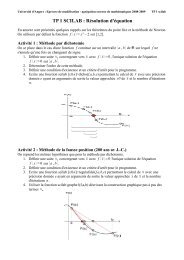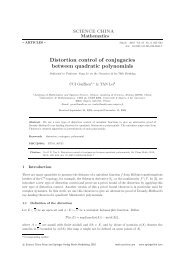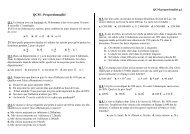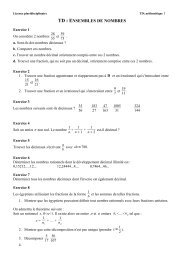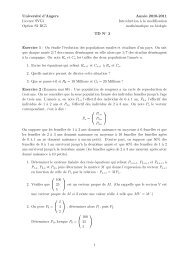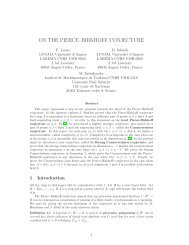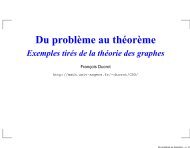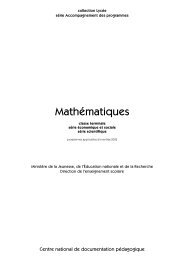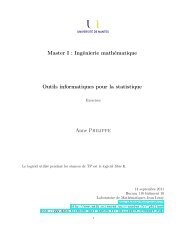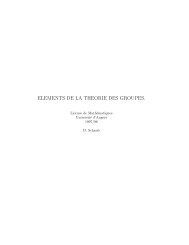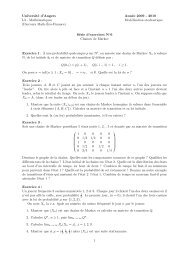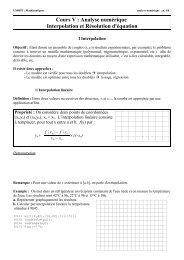automorphisms of real rational surfaces and weighted blow-up ...
automorphisms of real rational surfaces and weighted blow-up ...
automorphisms of real rational surfaces and weighted blow-up ...
You also want an ePaper? Increase the reach of your titles
YUMPU automatically turns print PDFs into web optimized ePapers that Google loves.
WEIGHTED BLOW-UP SINGULARITIES ON REAL RATIONAL SURFACES 6<br />
Therefore, if<br />
ˆq(x0,x1)y0 + ˆp(x0,x1)y1 = 0, <strong>and</strong><br />
ˆq(x0,x1)y1 = 0<br />
then y1 = 0 <strong>and</strong> y0 = 0. It follows that ϕ is a well defined algebraic map<br />
from P 1 (R) × P 1 (R) into itself. <br />
Definition 2.4. Let P be a curvilinear subscheme <strong>of</strong> S 1 ×S 1 . We say that P<br />
is vertical if P is tangent to a vertical fiber {x} × S 1 , for some x ∈ S 1 , i.e.<br />
if the scheme-theoretic intersection P · ({x} × S 1 ) is not reduced.<br />
Lemma 2.5. Let P1,... ,Pℓ be mutually disjoint curvilinear subschemes<br />
<strong>of</strong> P 1 (R) × P 1 (R). Then there is an algebraic automorphism ϕ <strong>of</strong> P 1 (R) ×<br />
P 1 (R) such that<br />
for all i.<br />
• ϕ(Pi) is based at the point (i,0) <strong>of</strong> P 1 (R) × P 1 (R), <strong>and</strong><br />
• ϕ(Pi) is not vertical,<br />
Pro<strong>of</strong>. By Theorem 2.2, we may assume that P1,... ,Pℓ are based at the<br />
points (1,0),... ,(ℓ,0) <strong>of</strong> the <strong>real</strong> algebraic torus P 1 (R)×P 1 (R), respectively.<br />
Let vi = (ai,bi) be a tangent vector to P 1 (R)×P 1 (R) at Pi that is tangent<br />
to Pi. This means the following. If Pi is an ordinary point then vi = 0. If<br />
Pi is not an ordinary point then vi = 0 <strong>and</strong> the 0-dimensional subscheme<br />
<strong>of</strong> P 1 (R) × P 1 (R) <strong>of</strong> length 2 defined by vi is contained in the closed subscheme<br />
Pi <strong>of</strong> P 1 (R) × P 1 (R).<br />
Let p,q ∈ R[y] be <strong>real</strong> polynomials in y <strong>of</strong> the same degree such that<br />
• q does not have any <strong>real</strong> roots,<br />
• p(0) = 0, q(0) = 1, q ′ (0) = 0 <strong>and</strong><br />
• ai + bip ′ (0) = 0 whenever vi = 0.<br />
Define ϕ: P1 (R) × P1 (R) −→ P1 (R) × P1 (R) by<br />
<br />
ϕ(x,y) = x + p<br />
q ,y<br />
<br />
.<br />
According to Lemma 2.3—exchanging x <strong>and</strong> y—the map ϕ is an algebraic<br />
automorphism <strong>of</strong> P 1 (R) × P 1 (R). Since p(0) = 0, one has ϕ((i,0)) = (i,0).<br />
It follows that ϕ(Pi) is also based at (i,0).<br />
The Jacobian <strong>of</strong> ϕ at (i,0) is equal to<br />
<br />
1<br />
D (i,0)ϕ =<br />
0 1<br />
p ′ (0)q(0)−p(0)q ′ (0)<br />
q(0) 2<br />
<br />
=<br />
<br />
1 p ′ (0)<br />
0 1<br />
By construction, (D (i,0)ϕ)vi has first coordinate nonzero whenever vi = 0.<br />
Therefore, ϕ(Pi) is not vertical, for all i. <br />
Pro<strong>of</strong> <strong>of</strong> Theorem 2.1. Let P1,... ,Pℓ be mutually disjoint curvilinear subschemes<br />
<strong>of</strong> the <strong>real</strong> algebraic torus P 1 (R) × P 1 (R) <strong>of</strong> orders e1,... ,eℓ, respectively.<br />
Let Qi be the curvilinear subscheme <strong>of</strong> P 1 (R) ×P 1 (R) defined by<br />
the ideal ((x − i) ei ,y) in R(P 1 (R) × P 1 (R)). It suffices to show that there<br />
is an algebraic automorphism ϕ <strong>of</strong> P 1 (R) × P 1 (R) such that ϕ(Qi) = Pi for<br />
all i.


